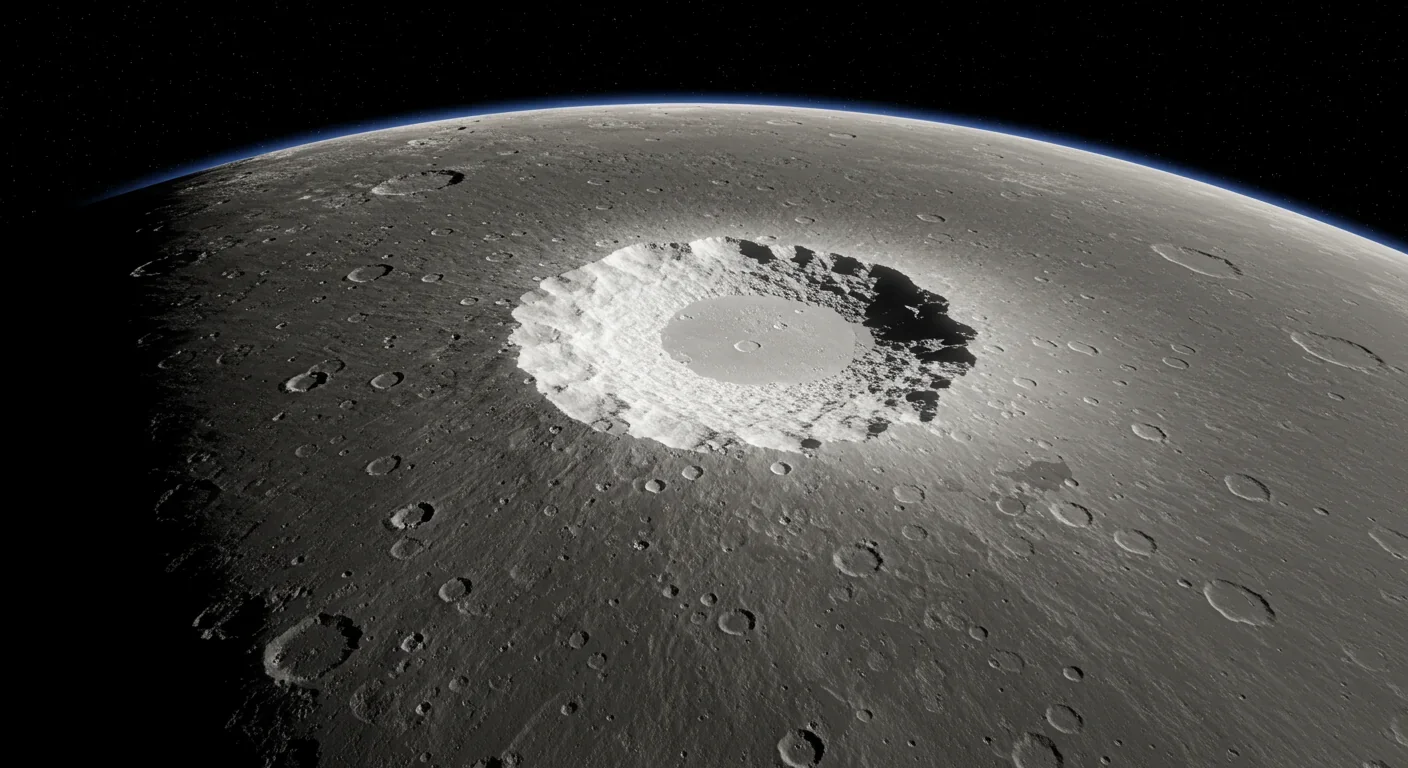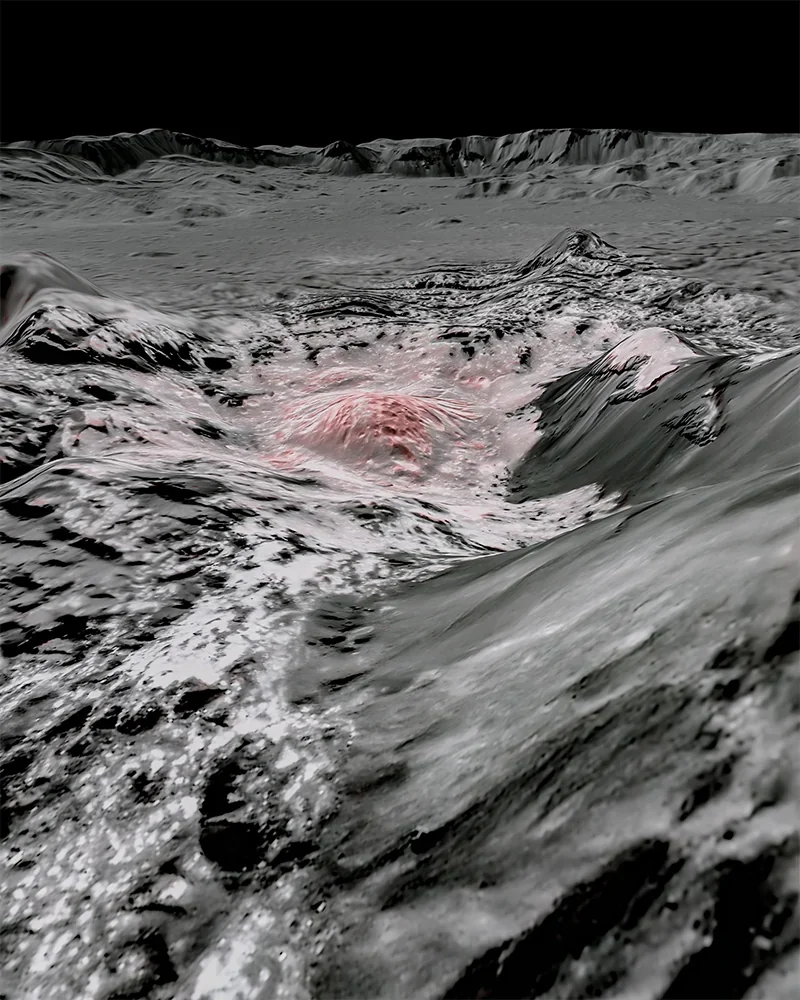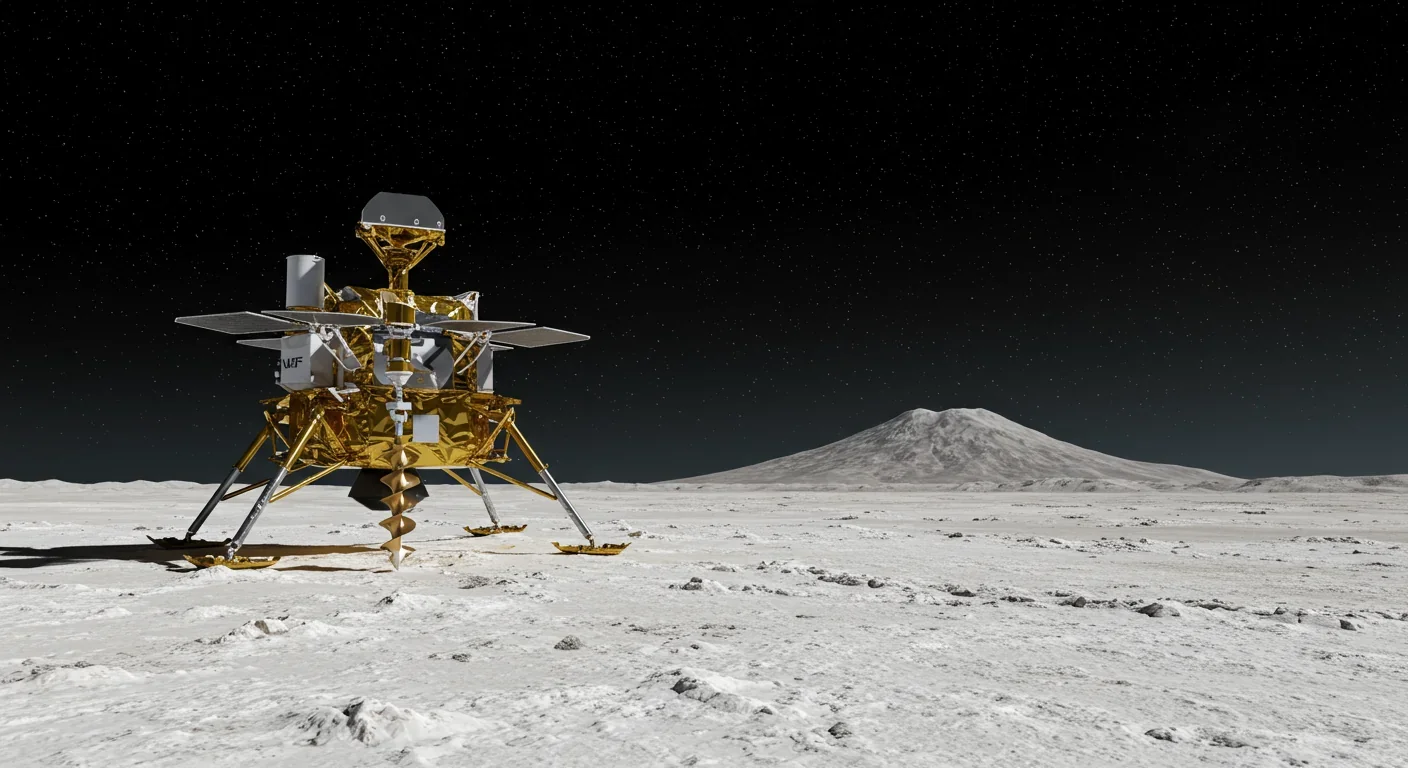The Gravity Heresy: MOND vs Dark Matter Theory Explained

TL;DR: Ceres harbors a subsurface ocean beneath its icy crust, challenging assumptions about where life could exist. This discovery suggests ocean worlds may be far more common than expected, transforming our understanding of habitable environments in our solar system and beyond.

By 2035, scientists predict humans will have drilled through the icy crust of a dwarf planet to sample an alien ocean. That world isn't Europa or Enceladus, the usual suspects. It's Ceres, a frozen outpost barely 600 miles across, lurking between Mars and Jupiter. And new evidence suggests this unassuming rock has been hiding a secret ocean the entire time.
In August 2020, NASA confirmed what planetary scientists suspected: Ceres harbors a deep reservoir of briny water beneath its surface, creating brilliant white deposits that shine across its dark terrain. This wasn't ancient frozen relic. The water appears chemically active, mineral-rich, and geologically recent—potentially only millions of years old in a 4.6-billion-year-old solar system.
If Ceres, the largest asteroid, contains liquid water and organic materials, our assumptions about where life could emerge need serious revision.
NASA's Dawn spacecraft spent years orbiting Ceres between 2015 and 2018, mapping every crater and measuring gravity variations. The team found anomalies they couldn't explain—bright spots in Occator crater reflecting light with unusual intensity, gravity readings suggesting something fluid beneath the crust, and spectral signatures matching sodium carbonate and ammonium chloride.
These weren't fingerprints of ancient ice. They indicated fresh briny water reaching the surface within recent geological time.
UC Berkeley researchers combined Dawn's gravity measurements with thermal modeling and spectroscopy. They found a 400-kilometer-wide brine reservoir roughly 40 kilometers beneath Occator crater. The brine wasn't static—it migrated upward through ice fractures, carrying dissolved salts to crystallize at the surface.
Even more intriguing: the water existed for extended periods, suggesting Ceres maintained internal heat long enough to keep subsurface water liquid despite being far from the Sun. For such a small world to retain heat challenges everything scientists thought they knew.
This discovery echoes patterns across our solar system's early history. Four and a half billion years ago, water was everywhere. Ice and organic molecules permeated the disk of gas and dust around our young Sun. Asteroids and comets became delivery vehicles for primordial water.
The asteroid belt formed from material that never coalesced into a full planet, thanks to Jupiter's gravity. These fragments preserved chemical records of the early solar system—frozen snapshots from before Earth had oceans. Many asteroids contain significant water ice, but Ceres stood apart.
At 590 miles in diameter, Ceres represents roughly a third of the asteroid belt's total mass. It formed far enough from the Sun to retain water ice but close enough for radioactive heating from aluminum-26 and iron-60 decay. This combination—water, heat, organic materials, and billions of years—creates conditions surprisingly similar to those that sparked life on Earth.
Scientists assumed small rocky bodies cooled quickly. Ceres proves that wrong. The dwarf planet may have maintained liquid water for billions of years, far longer than expected. That timeline opens disturbing possibilities: Could life have emerged there? Could it persist now?
Mars was habitable for perhaps a few hundred million years before losing its atmosphere. Ceres might have provided stable aquatic environments far longer, insulated beneath protective ice.
Understanding how Dawn detected Ceres' ocean requires grasping three complementary techniques.
First, gravity field mapping. As Dawn orbited, scientists measured variations in how strongly Ceres pulled on the spacecraft. Dense materials create stronger pulls; less dense materials produce weaker ones. The gravity anomaly beneath Occator suggested something less dense than rock but denser than pure ice—consistent with a brine reservoir.
Second, spectroscopy. Different minerals absorb and reflect light at characteristic wavelengths. Dawn's infrared spectrometer detected patterns matching sodium carbonate and ammonium chloride—compounds forming when briny water evaporates. These deposits appeared geologically fresh, unweathered by micrometeorite bombardment.
Third, thermal modeling. Scientists simulated heat movement through Ceres' interior over billions of years. Models showed radioactive decay and gravitational compression could keep subsurface water liquid far longer than surface conditions suggested. Combined with observed features, evidence showed brine reached the surface within the past few million years—yesterday in geological terms.
The process works like this: Residual formation heat and radioactive decay warm the deep interior, slowly melting the boundary between ice and rock, creating liquid water pockets. Because brine is less dense than surrounding material, it migrates upward through cracks. When reaching the frigid surface, water sublimates into space, leaving concentrated salt deposits.

The Ceres discovery forces fundamental recalculation of where ocean worlds might exist.
Previously, scientists focused on gas giant moons—Europa, Enceladus, Titan—where tidal heating from massive planets keeps subsurface water liquid. This requires specific orbital relationships: a large planet, an elliptical moon orbit, and gravitational tugging that flexes interiors, generating friction and heat.
Ceres doesn't fit this model. It orbits independently, with no gas giant flexing its interior. Yet it maintained subsurface liquid water anyway, through radioactive heating, residual formation heat, and possibly chemical reactions between water and rock. This suggests ocean worlds might be far more common than predicted.
If a small, solitary dwarf planet harbors liquid water, what about hundreds of similar bodies in the outer solar system? The Kuiper Belt contains thousands of icy bodies comparable to Ceres. Pluto, Eris, Makemake, Haumea—all could host subsurface oceans. So could dozens of trans-Neptunian objects we haven't studied.
The implications are staggering. Instead of a handful of ocean worlds in our solar system, there might be dozens or hundreds. If this pattern holds across other star systems, potentially habitable environments in our galaxy increase by orders of magnitude.
Ceres demonstrates habitability doesn't require planets in the "Goldilocks zone" with surface liquid water. Life could emerge and persist in subsurface oceans across much wider ranges—smaller bodies, greater distances from stars, colder temperatures. The universe might be far more habitable than we thought, just not visibly.
The story gets more promising when we add organic molecules.
In 2017, Dawn detected concentrated organic materials across portions of Ceres' surface, particularly around Ernutet crater. These carbon-based compounds appear indigenous to Ceres, not delivered by impacts. Combined with subsurface water, they create basic ingredients for biochemistry: liquid water as solvent, organic molecules as building blocks, and dissolved minerals providing chemical energy.
Recent analysis reveals Ceres may have hosted even more remarkable features: chemical energy sources capable of supporting metabolism. When water interacts with certain minerals in Ceres' interior, it triggers reactions called serpentinization that release hydrogen gas and methane—the same process sustaining ecosystems around Earth's deep-sea hydrothermal vents.
On Earth, microbes called methanogens thrive in these environments, metabolizing hydrogen and carbon dioxide to produce methane and water. They require no sunlight, no oxygen, just chemistry. Similar organisms could theoretically survive in Ceres' subsurface ocean, sustained indefinitely by slow reactions of water with rock.
Some researchers remain skeptical about Ceres hosting life, noting we have no direct samples and no way to measure biological activity remotely. Fair points. But the chemical prerequisites clearly exist: liquid water, organic molecules, energy sources, and billions of years for chemistry to experiment.
Whether life emerged there remains unknown. But Ceres demonstrates necessary conditions existed—and might still exist—much closer than anyone expected.
While studying Ceres' ocean, scientists discovered another surprise: the dwarf planet appears geologically active, featuring ice volcanoes that erupt cold brine rather than molten rock.
The most prominent example is Ahuna Mons, a 13,000-foot mountain with steep sides and distinctive shape unlike any impact crater. Researchers believe it formed when pressurized brine forced through the crust and erupted onto the surface, freezing into a dome-shaped mountain. The process, called cryovolcanism, has been observed on icy moons but never before on an asteroid.
Ahuna Mons appears relatively young—perhaps only a few hundred million years old—suggesting Ceres remained geologically active into recent past. Other features show evidence of similar cryovolcanic activity, though heavily modified by subsequent impacts.
This matters because it provides mechanisms for bringing subsurface materials to the surface, where future missions might analyze them. Rather than drilling through kilometers of ice, scientists could study cryovolcanic deposits that naturally erupted from the interior. These deposits would preserve chemical fingerprints of the subsurface ocean, potentially including organic molecules or even biosignatures.
The bright spots in Occator crater represent similar phenomena—recent upwelling of brine that crystallized at the surface. These deposits appear to brighten and dim on seasonal cycles, possibly indicating ongoing sublimation of water ice mixed with salts. If so, Ceres remains active today, with subsurface fluids continuing to migrate surfaceward.

Different international space agencies have approached Ceres with varying priorities reflecting their scientific and strategic interests.
NASA's Dawn mission exemplifies American strengths in robotic exploration—long-duration missions that comprehensively characterize distant objects. Dawn spent over three years at Ceres, descending through multiple orbital phases to image the surface at increasingly higher resolution. The mission prioritized understanding Ceres' formation, composition, and evolutionary history.
The European Space Agency has expressed interest in future Ceres exploration, particularly detecting biosignatures or testing life-detection technologies. ESA's approach emphasizes international collaboration and open data sharing, viewing space exploration as human endeavor rather than national competition.
China's space program includes plans for asteroid missions, though Ceres hasn't been publicly identified as a near-term target. China focuses on missions demonstrating technical capability while advancing scientific knowledge—returning samples, landing on distant objects, deploying rovers. A Ceres landing mission would check all these boxes.
Private space companies, particularly those developing heavy-lift launch capabilities, see Ceres differently—as a potential resource depot. The dwarf planet's abundant water ice could theoretically be mined and processed into rocket fuel, creating a refueling station between Earth and the outer solar system.
These differing perspectives create both opportunities and tensions. Pure science missions prioritize understanding over exploitation; commercial ventures need return on investment; strategic interests involve demonstrating national capabilities. Finding frameworks that advance all goals simultaneously—and ensure no single nation or company monopolizes access—will require unprecedented international cooperation.
NASA and ESA have explored concepts for follow-up missions to Ceres, though none have secured funding yet. Proposed missions range from orbiters with advanced instrumentation to landers sampling surface materials or even drilling into the subsurface ocean.
The most ambitious concept involves a penetrator probe impacting Ceres at high velocity, punching through the ice crust to release a sensor package into the subsurface ocean. Similar to concepts proposed for Europa, this approach would allow direct water sampling, measuring temperature, salinity, chemistry, and potentially detecting organic molecules or microorganisms.
Such missions face enormous technical challenges. Ceres' gravity is weak—only 3% of Earth's—making controlled descent difficult. The ice crust could be dozens of kilometers thick, requiring extraordinarily durable penetrators. Any instrumentation surviving impact must operate in near-total darkness, extreme cold, and crushing pressure, transmitting data through kilometers of ice to relay orbiters above.
Yet these challenges aren't insurmountable. Engineers have developed concepts for nuclear-powered ice-penetrating probes that slowly melt through ice using radioactive heat, unreeling communications cables as they descend. Such probes could reach Ceres' ocean in months or years, then deploy sensors to study the environment.
Alternative approaches focus on studying cryovolcanic deposits and bright spots from orbit or with landers, avoiding subsurface access complexity. These surface materials likely contain samples brought up from the ocean through natural geological processes. High-resolution spectroscopy, ground-penetrating radar, and sample return missions could characterize these deposits in detail.
The discovery of Ceres' ocean won't change your daily life immediately, but it reshapes fundamental questions about humanity's place in the cosmos.
Every generation inherits assumptions about what's possible, what's normal, what defines existence limits. For centuries, Earth was the only world—humanity alone, life unique, our planet special. Then we learned Earth orbits the Sun. That other planets exist, many larger. That our solar system is one among billions in a galaxy that's one among trillions.
Each discovery compresses our sense of uniqueness. We're not central, not special, not alone in any cosmic sense. Ceres represents another step: life's requirements might be common, scattered across worlds we dismissed as barren rocks.
For young people choosing careers, this creates opportunities. Planetary science, astrobiology, space engineering—these fields will define the 21st century's greatest discoveries. The first person to detect life beyond Earth has probably already been born, possibly reading these words now.
For everyone else, Ceres invites perspective. We live on a water world orbiting an average star in an unremarkable galaxy. Liquid water and organic molecules exist throughout the solar system, probably throughout the universe. Whatever makes life possible isn't rare or precious—it's common, persistent, widespread.
That realization should make us humble. We're not the universe's grand achievement. But it should also make us determined, because if life's ingredients exist everywhere, then consciousness, intelligence, and civilization might be rare. We could be among the first minds to wake up and look outward, to recognize the cosmos and begin exploring it.
Ceres forces these questions into focus. A frozen dwarf planet, four hundred million miles away, holding an ocean beneath ice—and possibly, just possibly, holding answers to the oldest question our species has ever asked: Are we alone?
Humanity stands at a threshold. For the first time, we possess technology to explore other worlds not just with telescopes and rovers, but potentially with submarines and drilling rigs, with life-detection experiments and sample-return missions that could bring alien water—maybe alien microbes—back to Earth.
Ceres won't be the last ocean world we discover. It might not even be the most interesting. But it's close, accessible, and waiting. Within your lifetime, we might know whether it harbors life. Within your children's lifetimes, humans might walk on its surface, drill through its ice, and swim in its alien sea.
The ocean beneath Ceres' ice exists right now, this moment, while you read these words. It's been there for billions of years—patient, hidden, unchanging. Waiting for us to arrive, to investigate, to understand.
Every great journey begins with a single step. Dawn took that step, revealing Ceres' secrets. The next steps—landing, drilling, exploring—will define whether we're a species content to observe or one driven to discover.
The ocean is there. The question is: What will we find when we finally reach it?

MOND proposes gravity changes at low accelerations, explaining galaxy rotation without dark matter. While it predicts thousands of galaxies correctly, it struggles with clusters and cosmology, keeping the dark matter debate alive.

Ultrafine pollution particles smaller than 100 nanometers can bypass the blood-brain barrier through the olfactory nerve and bloodstream, depositing in brain tissue where they trigger neuroinflammation linked to dementia and neurological disorders, yet remain completely unregulated by current air quality standards.

CAES stores excess renewable energy by compressing air in underground caverns, then releases it through turbines during peak demand. New advanced adiabatic systems achieve 70%+ efficiency, making this decades-old technology suddenly competitive for long-duration grid storage.

Our brains are hardwired to see patterns in randomness, causing the gambler's fallacy—the mistaken belief that past random events influence future probabilities. This cognitive bias costs people millions in casinos, investments, and daily decisions.

Forests operate as synchronized living systems with molecular clocks that coordinate metabolism from individual cells to entire ecosystems, creating rhythmic patterns that affect global carbon cycles and climate feedback loops.

Generation Z is the first cohort to come of age amid a polycrisis - interconnected global failures spanning climate, economy, democracy, and health. This cascading reality is fundamentally reshaping how young people think, plan their lives, and organize for change.

Zero-trust security eliminates implicit network trust by requiring continuous verification of every access request. Organizations are rapidly adopting this architecture to address cloud computing, remote work, and sophisticated threats that rendered perimeter defenses obsolete.